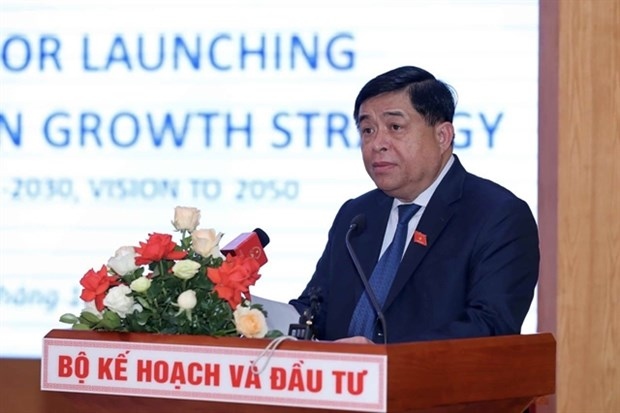Green growth strategy promotes post-COVID-19 economic recovery
The national strategy on green growth for 2021-2030, with a vision to 2050 plays a crucial role in promoting economic restructuring alongside growth model renovation, said Minister of Planning and Investment Nguyen Chi Dung.

“It is an important approach to pursue sustainable development, thus contributing to post-COVID-19 economic recovery, transitioning to green economic development, and at the same time creating a premise to realise the long-term targets of low-carbon emissions and carbon neutrality so as to contribute to limiting global temperature rise,” he said.
Minister Dung made the statement at a conference to implement the strategy chaired by the Ministry of Planning and Investment in Hanoi on October 29.
Attendees at the conference included representatives from ministries, sectors, localities, embassies of the UK, Germany, the Republic of Korea, international organisations, the World Bank, Asian Development Bank, UNDP, UNIDO, UNICEF, GIZ, KOICA, AFD, USAID, as well as representatives from businesses, academia, and researchers.
In light of the approved orientation, the strategy was developed on the basis of extensive consultations with stakeholders in ways consistent with recent COVID-19-pandemic prevention regulations, the minister said.
The development process of the strategy received strong support, cooperation and input from ministries, sectors, localities, relevant industry associations, embassies, international organisations, and development partners, he said.
By acknowledging and taking into consideration the inputs from stakeholders, the Ministry of Planning and Investment has completed the strategy and submitted it to the Prime Minister for promulgation under Decision No 1658/QDTTg dated October 1, 2021.
The Prime Minister's approval of the strategy on the threshold of the 26th Conference of the Parties to the United Nations Framework Convention on Climate Change (COP26) in Glasgow, UK, which will take place in the next few days, has demonstrated Vietnam's strong commitment to reducing greenhouse gas emissions through practical and concrete actions.
“The strategy sets four important goals, namely reducing greenhouse gas emissions, greening economic sectors; greening lifestyles and promoting sustainable consumption, and greening the transition,” said Le Viet Anh, Director of the Department of Science, Education, Natural Resources and Environment under the Ministry of Planning and Investment.
“The first objective of the strategy is to reduce the intensity of greenhouse gas emissions per GDP, which was also the objective of the previous strategy. This aims to assess comparative greenhouse gases (GHG) emission mitigation potential per unit of economic output, helping to determine the extent of environmentally-friendliness of the economy as its size is increasing, contributing to realising the dual goal of protecting the environment and developing “rapidly and sustainably,” he said.
Under the strategy, by 2030, the intensity of greenhouse gas emissions per GDP will decrease by at least 15% compared to that of 2014. By 2050, the intensity of greenhouse gas emissions per GDP will reduce at least 30% compared to that of 2014.
Hai Phong was the first locality to develop and implement a green growth plan for the 2014-2020 period. The city has succeeded in attracting a number of sustainable investment projects in accordance with the local economic development conditions.
Vice Chairman of the Hai Phong municipal People's Committee Le Khac Nam said that the city had implemented a number of outstanding projects in the 2014-2020 period, such as waste treatment projects and an electric bus on Cat Ba island.
International organisations have supported and co-ordinated with Hai Phong to implement green and environmentally friendly projects. The city will move towards applying digital technology, digital transformation, transforming the economic model towards greening, comprehensively implementing green economic development models including green ports, green islands, environmentally-friendly production model, reducing energy consumption in production activities, and applying renewable energy sources such as wind and wave energy.
Representatives from ministries, sectors, localities, embassies, international organisations, development partners, and businesses spoke highly of the new approach which was employed to determine the feasibility of the goals set forth in the strategy.
They also agreed with the plan and roadmap for the implementation of the strategy and believe that the Strategy will help realise the goals that Vietnam had set for 2030 and 2045. Ministries, sectors, localities, agencies and relevant organisations agreed to work together immediately to devise a National Green Growth Action Plan and Action Plans on sectoral and local levels. Development partners and international organisations are committed to accompanying and supporting Vietnam to implement the strategy.
To conclude the meeting, Minister Dung emphasised the importance of collaboration during the implementation process, saying the support and close coordination of ministries, sectors, domestic and international organisations, the business community and experts play a fundamental role to ensure that the implementation of the strategy adheres to the views and orientations of the Resolution of the 13th National Party Congress, the 10-year socio-economic development strategy 2021-2030, and the 5-year socio-economic development plan 2021-2025.
Following the conference, the Ministry of Planning and Investment will preside over and coordinate with ministries, sectors and localities to research and propose to the Prime Minister to establish a national steering committee on green growth, make arrangements to devise a national green growth action plan, and implement other important contents.
